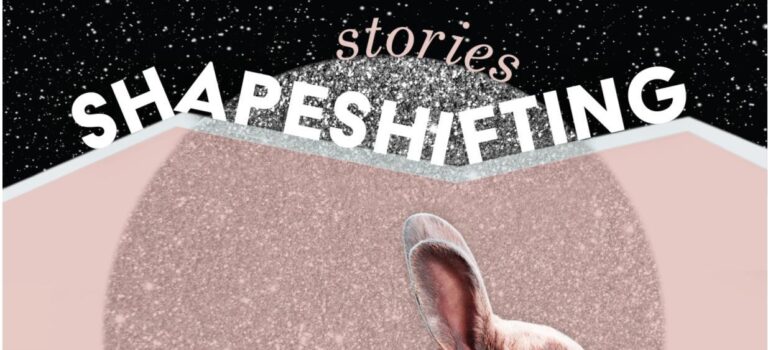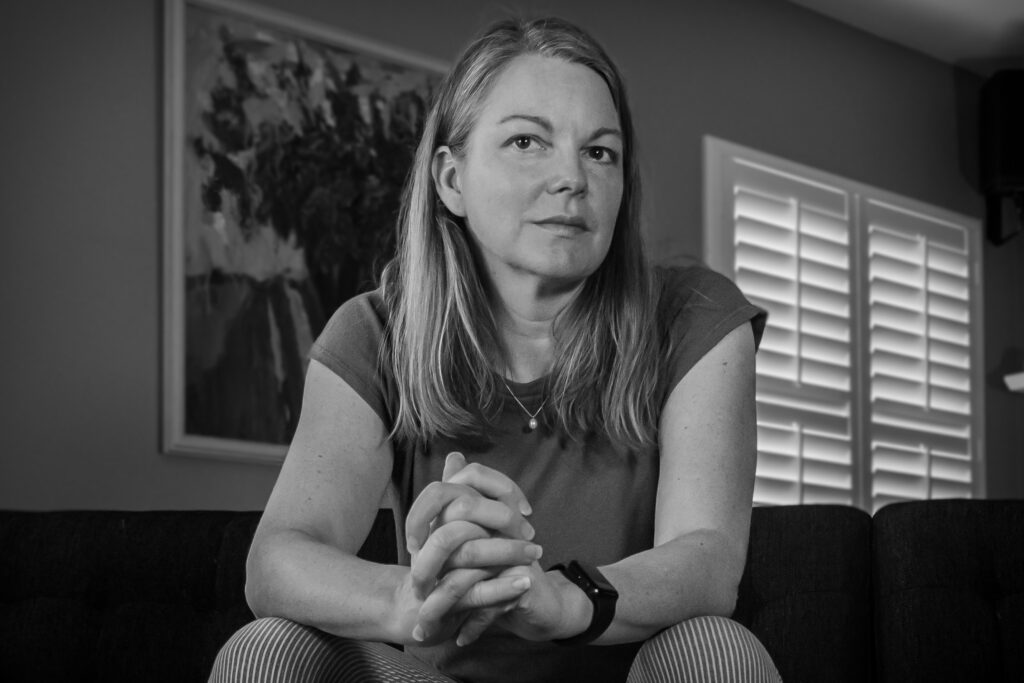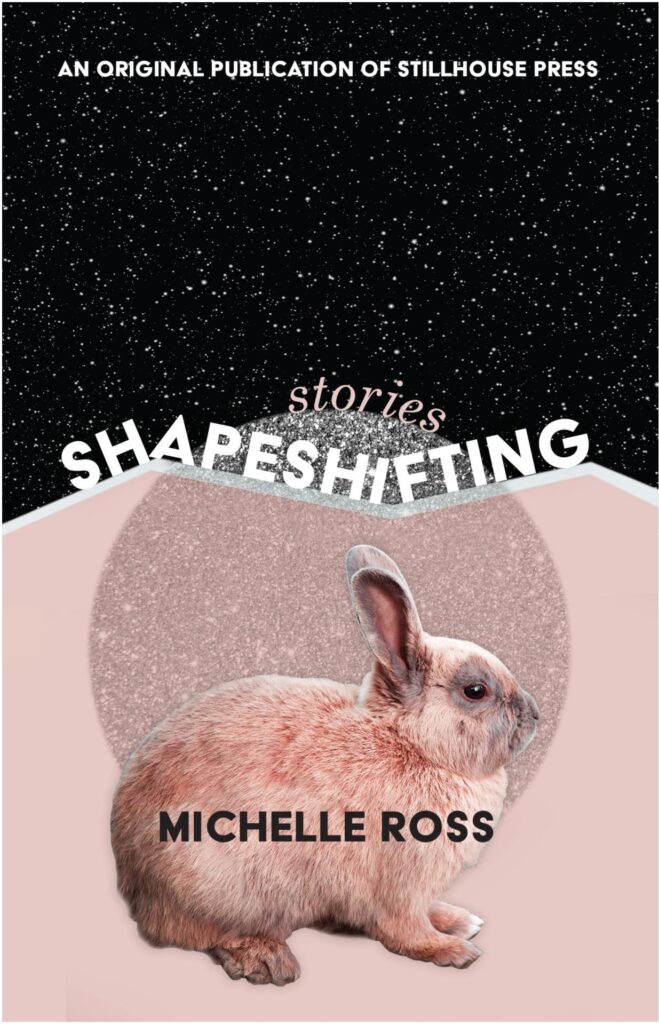
Michelle Ross

Shapeshifting: An Interview with Michelle Ross
We’re so excited to share an interview with past contributor Michelle Ross about her new short story collection, Shapeshifting. The book came out in November from Stillhouse Press. The interview was conducted via email by our blog editor, Sara Walker.
Sara Walker: Just about all the stories center on motherhood, children, and those relationships. What inspired this?
Michelle Ross: My first story collection There’s So Much They Haven’t Told You was less unified in its focus, so for my second collection, I wanted to be more deliberate with theme. As the mother of a young child, I found myself, perhaps inevitably, drawn to writing fiction about motherhood and mothers. Motherhood has been a big part of my lived experience these last eleven years. It’s on my mind. I’ve been mentoring high school writers for several years now via the Adroit Journal’s Summer Mentorship Program, and there’s this passage I quote from Lorrie Moore in my syllabus about the importance of writing about what’s on your mind, what you care about. One of the things she says is “You really have to write from the center.” She talks about how one of the big mistakes her students make is that they write about topics they don’t really think about or care about. I think it’s impossible to write well about a topic you’re not at least a little bit obsessed with. Trying to fake it won’t do. The story will be missing something crucial. I see that in the submission queue for Atticus Review, where I’m fiction editor: some stories are missing that spark of energy that you just can’t fake, and I think that whether or not a story has that spark has a lot to do with whether the writer is writing from the center.
SW: Why is it important to you to highlight the imperfection of motherhood and feelings of imposter syndrome?
MR: I was grappling with many questions in these stories—the impossible pressures put on mothers, the erasure of motherhood, what mothers owe their children, the tremendous power mothers have over their children, the violence and cruelty of children—but most of all I just wanted to write honestly about motherhood. No sugarcoating. No prettying things up. That’s what I want to do with any topic I write about. And one of the truths of motherhood is that no one is born a mother. There’s so much mythologizing about motherhood—that nurturing comes naturally to mothers, for example; that it comes naturally to women and girls in general. But the truth is more complicated. Nurturing isn’t an inherently female trait. It’s at least partly a learned trait. If you’ve rarely, if ever, been nurtured by someone, how do you learn to nurture another person? It wasn’t until my son was born that I really and fully grasped how incredibly vulnerable children are and how, therefore, incredibly easy it is for parents to harm their children; and, of course, the world is full of adults who were harmed by their parents, and many of those adults have children of their own.
SW: What is it about “Shapeshifting” that made you choose it as the title story?
MR: While the book’s title did come from the title story, the book was not titled after the title of that story; at the time, “Shapeshifting,” the story, had a different title altogether. It was originally published in The Pinch as “Gestation.” The real inspiration for the book’s title was a metaphor within the story. The pregnant protagonist in the story says that as a kid she liked the idea of being a shapeshifter but that it didn’t occur to her that pregnant women are shapeshifters, too: “Shapeshifting isn’t the way I’d imagined it. I’d always pictured myself behind the wheels of other bodies I assumed. This is the opposite. I’m the wheels, not the driver.” I wasn’t yet finished writing all the stories in this book when I decided that Shapeshifting was the perfect title. All humans are shapeshifters (consider puberty, for example), but I’d say mothers are a particularly interesting kind of shapeshifter. Motherhood is a strange metamorphosis. Mothers might come out of pregnancy looking more or less like they did before, but the world sees them as other than who they were. Whatever kind of mother one is, motherhood changes one in a deep way. There is no going back.
I’m not much of a fan of books sharing the same title as a story within. I’m wary of giving so much weight to one particular story. But when the editors at Stillhouse Press suggested I retitle this story to match the book’s title, I agreed that it was a better title for the story, too; and I kind of like that the story was titled after the book rather than the other way around.
SW: “The Sand and the Sea” is written in a different format – almost like vignettes, rather than a straightforward narrative. How did you make that choice?
MR: This story originated in a weekend workshop I took with the phenomenal Kathy Fish some years ago. The exercise was to write a braided flash piece. If I remember correctly, I think we started by creating three columns on a piece of paper and each column was dedicated to a different thread. I know that one of the threads was to be composed of lines that began with language such as “I wonder…” or “I wish…” I believe the other threads were supposed to be two different time periods in the character’s life? I played for many, many months after that workshop with the pieces I’d written—rearranging, cutting, adding, trying to get the right pieces in the right order. In a way, I felt like I was going back to my roots in this story. When I first started writing short stories seriously in college, the writer who changed everything for me was Amy Hempel. I had struggled with plot, with how to string sentences and paragraphs together in such a way that they were a story. Long scenes, long exposition felt unwieldy. Then I read Reasons to Live and fell so in love with how Amy Hempel constructs her stories out of these concise little fragments—scenes lasting no more than a paragraph or a page or so. Of course, some of those stories aren’t just pieced together somewhat like a series of flash fictions, but some are flash fictions. I didn’t learn the term “flash fiction” until several years later, and I don’t think I tried writing my own flash fictions until many years after that. However, I did start writing and thinking about writing differently after reading Hempel—thinking about stories in a more modular way, as composed of these tight little units that I could rearrange to different effects. Many years would pass before I would try once again to write stories that weren’t so modular.
SW: Which story was the most challenging to write? Why?
MR: Most stories are challenging for me, honestly. I work on stories, including flash fictions, for many months, often many years, before finishing and submitting them. Maybe I should answer this question backwards. One of the easiest stories for me to write was “A Mouth is a House for Teeth.” The general premise and tone of it came to me quickly. Then, before I’d written much of anything down, I floated in one of those so-called sensory deprivation tanks for the first time. I spent pretty much the whole hour thinking about that story. It was a weird and wonderful experience. I felt like I was alone floating out in the middle of a dark ocean, and this story was building in that darkness. After, I went to a coffee shop and wrote pretty much all day—by hand in a notebook, which I hate to say I rarely do these days, and probably should do more often. Writing by hand has a different kind of energy and rhythm. I can easily remember which stories of mine I first drafted by hand and which I first drafted on the computer. Anyway, after that I spent several weeks typing up the pieces, fitting them together, discovering what was missing, what could be cut, and so on. I think that from start to finish, that story took only a few months to finish, which for me is incredibly fast.
SW: “Keeper Four” approaches motherhood in a way different from the other stories; it’s sci fi-esque. What inspired this story?
MR: One of the primary inspirations was a book I’d read with my son when he was younger: Unlikely Friendships: 47 Remarkable Stories From the Animal Kingdom. The photos and stories in the book are endearing, but at the same time, this book creeped me out. Some of the unlikely friendships involved predators befriending prey. Some of the unlikely “friendships” weren’t friendships at all, but mother-child relationships. For example: a dog mothering a monkey. Of course, a mother-child relationship is quite a different kind of relationship than a friendship. We expect friendships to be reciprocal, not so much mother-child relationships. Sure, young children can be loving and kind, but even many of their more charming behaviors are largely driven by their own needs, their own survival. A very young child clings to their mother more for security and safety than out of “love.” That’s not a judgment; I think it’s only natural for a creature that is vulnerable and helpless to charm larger, more capable creatures into protecting it. Anyway, this book disturbed me. Something about the mislabeling of these relationships. Something about the way humans praise females of a species for being nurturing. Something about the oohing and aahing over predators refraining from doing what it is in their nature to do—to prey. From that disturbance was born the idea of humans experimenting to develop a drug to induce mothering behavior even in the most unlikely of candidates.
SW: What do you hope readers will keep with them after finishing Shapeshifting?
MR: I hope that readers find Shapeshifting to be greater than the sum of its parts. I see these stories as being in conversation with each other, and I think I’m able to achieve something more in the book as a whole than I could in individual stories. But that said, mostly I just hope readers find something of value in this book, whatever that may be for them as individuals—whether it be that they feel seen, that they feel less lonely, that they’re entertained, that these stories make them think, or that something is illuminated for them.
SW: You also write collaboratively with Kim Magowan. How did your experience with collaborative writing influence this collection?
MR: It’s when I’m feeling a bit in a slump that I’m mostly likely to nudge Kim into writing something together. Collaboration reminds me that writing is as simple on some level as making choices, and that all choices can be unmade, too. It helps train me to make choices quickly, to keep moving forward, instead of allowing a story to stagnate in indecision. It trains me to keep a story’s momentum going. When we collaborate, we typically pass a story back and forth rapidly, several times in a day sometimes. I write a few paragraphs, she writes a few paragraphs. Even a long story gets drafted within a week or so. That energy carries over into my own writing. Writing with Kim always renews my excitement for my own projects.
SW: What does your writing space look like?
MR: When my partner and I bought our house about fourteen years ago, it was important to me to be able to have a home office of my own. I wanted a room with a door, a room that was all mine, a room meant for nothing other than writing (and reading). This was important even back when we were in an apartment, only then we didn’t have all that much space so I had converted our walk-in closet into my writing space. Since the beginning of the pandemic, my home office is no longer just my writing space; it’s also where I do the job that pays the bills. Most of 2020 was a struggle because I was trying to do both these things at the same desk and on the same computer. When I tried to write fiction, I was distracted by work clutter. Early this year, I brought in a second desk and computer so that I have a writing half of my office and a work half of my office. Everything has gone much more smoothly since.
SW: What does writing mean to you?
MR: Writing is how I discover meaning and how I discover what I think. Writing is how I communicate most effectively. Writing is how I push back against the things that bug me. Writing makes me more present in my life, more observant. Writing is hard work but also immensely pleasurable. There’s no other way I’d rather spend my time.
Shapeshifting won the Stillhouse Press 2020 Short Fiction Prize and is available for purchase from Stillhouse Press. Check out more from Michelle on her website and read her stories in Issue 17 and Issue 20. Thank you so much, Michelle!
Guest Post, Michelle Ross, Kim Magowan: Delightful Anarchy: Why and How We Collaborate

Origin Story
Kim: It wasn’t our idea. Some journal—Sundog, I think—was running a collaboration contest, and Michelle proposed that we give it a shot. We each wrote an opening paragraph of a story and lobbed it to the other. The first of those stories has never been published—indeed, I think neither of us has submitted it anywhere for ages—though I still like it (recalling it now, I want to dust it off and send it to some journal). The second, “My Co-Worker Aldona,” is one of my favorites.
Michelle: Actually, I’d been thinking for some time about trying out collaborating, but it’s true it took the Sundog contest to motivate me to act on it. There was no question that Kim would be the writer I’d ask. Oddly enough, we didn’t actually end up submitting to the contest because by the time the deadline rolled around, our flash fictions had been accepted elsewhere (other than the one Kim mentions above that we’re less sure about).
Rules
Kim: We don’t have any. Michelle writes a few sentences and tosses it my way, I write more and toss it back. We decide when it’s done, and we edit together, sometimes as we go. We have no word count, no implicit or explicit regulation on when it’s time to lob the story to the other. Basically we toss it when we get stuck, or when we’ve handed the other person a good shoehorn in. It’s delightful anarchy.
Michelle: If there’s any rule it’s that we try to keep the momentum going by not letting a story sit for long. Often we lob a story back and forth several times in a day. Rarely do we allow a story to sit longer than a day or two.
Reasons to Do It
Kim: Because writing is lonely and isolating—one is isolated at one’s desk, isolated in one’s head. It’s much more fun to turn it into a conversation.
Because it’s fast! Solo, we each belabor a story, tweak it, tweeze it, get annoyed by it, and chuck it in a (metaphorical) drawer. Stories huddle in those drawers for years. When we’re collaborating, we run. We don’t wring our hands over a sentence: we hurl that smoking potato at the other. We wrote one of my favorites, “War,” in a day; it was accepted by Monkeybicycle the following day.
Because it’s good practice on how to adopt a different voice, try on a different style; it’s narrative dress-up.
Because it stretches us. I think we’re writing one kind of story, and then Michelle throws in some unforeseen element—a self-defense class, a book on how to fix home appliances, a surreally boring movie—and suddenly the story has morphed into something else altogether, something weird and unpredictable. The flower just became a cactus or a toucan.
Michelle: Because it’s tremendously freeing to surrender some of the control over a story’s plot and aboutness. Knowing that at Kim’s next turn she could take the story somewhere I don’t anticipate, I don’t need to concern myself too much with where the story will go. I can focus on where the story is now.
Because collaborating helps me break the bad habit of expecting too much of myself too quickly. That is, when I write a story solo, it’s tempting to sit at the computer too long, to exhaust myself to the point that when I finally walk away, I’m leaving on a low point instead of a high point. When all I have to concern myself with is the next paragraph or two, that’s a very doable task and a relatively a short time commitment. I’m much more likely to walk away from the computer feeling energized and eager to come back to the story when Kim returns it to me.
Because it’s fun.
Lessons Gleaned
Michelle: I feel I’ve learned so much from collaborating with Kim, but most importantly the value of writing in short bursts of an hour or so at a time, the value of keeping up the momentum by not letting a first draft sit unfinished for long (a terrible habit of mine), the value of pushing to the end before revising (another terrible habit of mine), and the value of not overthinking a first draft (terrible habit #3). I still make some of these mistakes in my own writing, but less and less so.
Kim: The best take-away for me is collaboration makes me freer and less fussy. Collaboration feels like the writing version of improvisation. It gets me out of ruts. Also, we are not at all proprietary about our parts of the story. I feel as comfortable changing a Michelle sentence as one of mine; I don’t have any sense of, “This part of the story belongs to me, this to Michelle.” In fact, I occasionally read a sentence in one of our stories and I can’t immediately remember which one of us wrote it (though if it’s about science, that’s a good clue that it’s Michelle! When I throw in something science-y—I think working with Michelle gives me the bug—there’s a good chance she’ll need to fix it. “Actually, I think you mean beakers”). Michelle and I have pretty different styles, so it’s been fascinating to me how well we blend.
Hassles
Michelle: Submitting collaborative fiction can be a bit trickier—figuring who will send a story where, keeping each other updated about where stories are being considered, where they’ve been rejected.
Kim: One journal wouldn’t allow us to submit a collaborative piece, which shocked us both.
How to Find Your Collaborator
Michelle: Obviously, you want to choose someone whose writing you admire and whose instincts you trust. It’s perfectly fine, and perhaps even for the best, if you have different writing styles or preoccupations as a writer. It’s also perfectly fine to disagree some of the time, as long as you’re able to resolve those disagreements. I think that ideally you should collaborate with a writer you know fairly well, with whom you already exchange drafts. Kim and I had been exchanging work for several years before we began collaborating. We were already each other’s first readers.
Kim: What Michelle said—find a writer whose work you love and whose judgments you value. Michelle and I first “met” each other over a story: I loved her story (“Cinema Verite”), and the comments I gave her were useful. Also, find someone who has strengths you want to borrow. I’ve always admired the humor in Michelle’s stories— her writing, like Lorrie Moore’s or Amy Hempel’s, makes me laugh. And I think our collaboration stories are pretty funny, even the sad ones. She lightens me. Michelle is ninja when it comes to restructuring stories, moving around pieces. It’s like being on one of those crazy Top Chef team quickfires: we’re good together because we can lean on each other’s skills.
Michelle: I do love moving pieces around. Quite often I find the fix to a story that isn’t quite working is largely in reshuffling the pieces. And funny that Kim says I lighten her with humor. I think Kim does the same for me plenty of the time. Also, I think that working with Kim makes be a better constructor of sentences. Her sentences are always at once so elegant and sharp, like dancers wielding scissors.

Michelle Ross is the author of There’s So Much They Haven’t Told You, which won the 2016 Moon City Press Short Fiction Award (MCP 2017). Her work has recently appeared in Cream City Review, The Forge, Monkeybicycle, TriQuarterly, and other venues. She is fiction editor of Atticus Review and a consulting editor for the 2018 Best Small Fictions anthology. She lives in Tucson, Arizona.
 Kim Magowan lives in San Francisco and teaches in the Department of Literatures and Languages at Mills College. Her short story collection Undoing won the 2017 Moon City Press Fiction Award and is forthcoming in 2018. Her novel The Light Source is forthcoming from 7.13 Books. Her fiction is published or forthcoming in Atticus Review, Bird’s Thumb, Cleaver, The Gettysburg Review, Hobart, New World Writing, Sixfold, Word Riot, and many other journals.
Kim Magowan lives in San Francisco and teaches in the Department of Literatures and Languages at Mills College. Her short story collection Undoing won the 2017 Moon City Press Fiction Award and is forthcoming in 2018. Her novel The Light Source is forthcoming from 7.13 Books. Her fiction is published or forthcoming in Atticus Review, Bird’s Thumb, Cleaver, The Gettysburg Review, Hobart, New World Writing, Sixfold, Word Riot, and many other journals.
Authors Talk: Michelle Ross
 Today we are pleased to feature author Michelle Ross as our Authors Talk series contributor. Michelle reads from and discusses her short story, “Stories People Tell.” She talks about how the story originated with a kind of confession of almost hitting a pedestrian with her car.
Today we are pleased to feature author Michelle Ross as our Authors Talk series contributor. Michelle reads from and discusses her short story, “Stories People Tell.” She talks about how the story originated with a kind of confession of almost hitting a pedestrian with her car.
You can read Michelle’s piece, “Stories People Tell,” in Issue 17 of Superstition Review.
Contributor Update, Michelle Ross: Find What’s Been Missing In “There’s So Much They Haven’t Told You”
Today, we here at the Superstition Review are emptying out the valves and shining the brass so that we can properly trumpet the release of Michelle Ross’ debut collection of stories There’s So Much They Haven’t Told You. This collection has already garnered a list of accolades and praise that you can really march to, most importantly the honor of the 2016 Moon City Press Fiction Award. Michelle Ross was featured in our 17th issue wherein she provided us with “Stories People Tell.” That story and many more are all contained in her There’s So Much They Haven’t Told You, which has been hailed by critics and readers alike as “fearless,” “exceptional,” and “the kind [of stories] I want tattooed on my skin.”
To pre-order this fantastic collection of stories, click here.
To learn more about Michelle Ross and her work, visit here website here.


